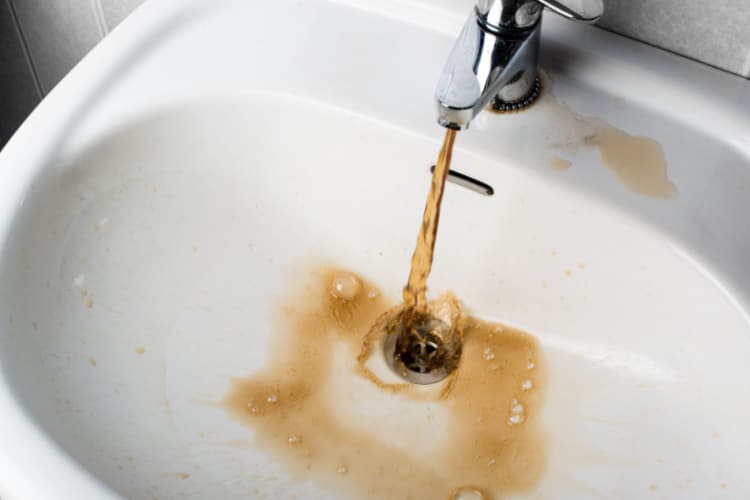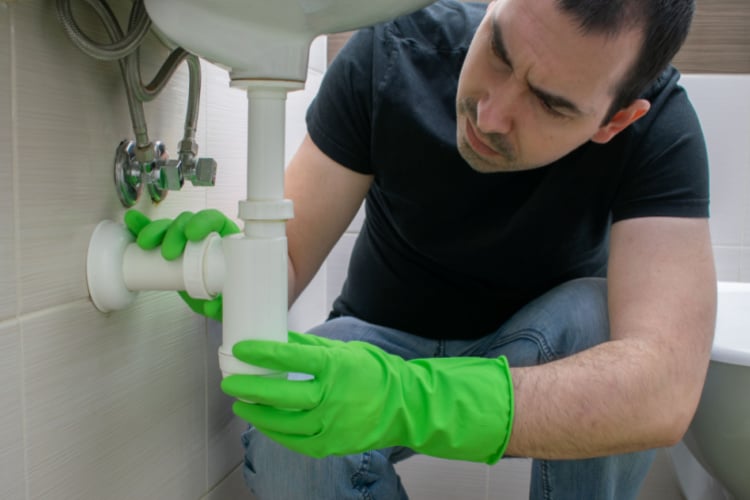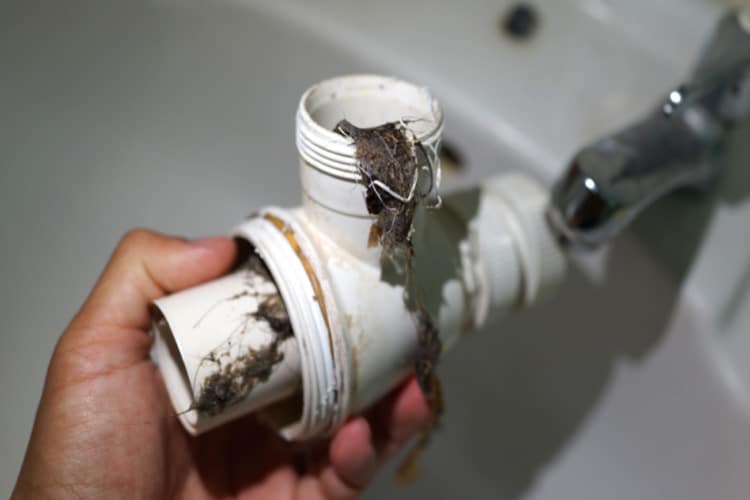Each time you turn on the faucet, the expectation is that clean, clear water will come out. However, there are also high chances that your water has been contaminated by sediments, dirt and contaminants that changes the color of the water to brown, yellow or orange. Brown water is a very common occurrence in the US, especially in states with poor water infrastructure.
Why is My Water Brown?
Brown water usually indicates the presence of rust, which contaminates the water as it flows through corroded water pipes. Old water pipes are the perfect breeding ground for rust, an iron oxide formed by the the reaction of iron and oxygen in the catalytic presence of water or air moisture. Rust gives water a reddish-brown color.

1. Rust in Corroded Water Pipes
Old pipes and those made of low-quality materials easily corrode and can leach rust, iron, or manganese into your water, giving it a brown color. The galvanized pipes that were mainly used before the 1980s are especially prone to corrosion and are the main source of serious water issues such as lead contamination.
Additionally, dirt and debris may easily get into the plumbing system at points of significant structural damage. Similarly, old pipes are more likely to break and let in rust and other contaminants.
Solution to rust and corroded pipes:
If the piping system is the likeliest suspect, have a plumber inspect it. In some cases, the problem may be extensive, and the only solution is to overhaul the whole system which will be quite expensive. However, sometimes the problem only arises because of a certain pipe gone rogue, and replacing a single pipe is easier and cheaper.
2. Routine Plumbing Repairs
Dirt or cleaning agents may get into the pipes during routine repairs, either inside the house or at the water source.
Regular flushes are normally done after routine repairs to remove contaminants, but these flushes may not remove all of the contaminants, which can cause the water to have a brown color.

Solution to routine plumbing repairs:
Check with your immediate neighbours who have the same supplier if their water is brown as well. If they are facing the same issue, the problem may be at the water source or in the municipal pipe system.
In such cases, you should request an inspection by the relevant city, town, or county departments. Such local authorities may also be your water suppliers, and they can quickly check if the problem is at the source and offer a remedy.
City/town inspectors are also authorized to check the sources of private suppliers. If any fault is found, they may close down the source or demand an overhaul of the supply system on public safety grounds.
3. Sediment Accumulation (At Source or In Transit)
Accumulation of sediment, which then mixes with water, is another important reason why your water may be brown. It occurs at two major points: at the source and in transit via water pipes.
Large amounts of sediments sand or dirt can easily cause the water to have a brown color. This particularly happens at the water source, and if it’s not adequately filtered by the supplier before distribution, the brown water will reach your taps and faucets.
While most water supply agencies strive to filter out most sediments and contaminants, technical failure or the system being overwhelmed by flooding may contribute to inadequate filtration.
Similarly, sediment accumulation may also occur in pipes that aren’t maintained regularly. Material deposits from pipe corrosion or even small amounts of silt or dirt build up can cause water discoloration.

Solution to sediment accumulation:
Turn on all the taps and let water run for at least 20 mins.
4. Water Flow Surge
While a normal water flow can’t remove sediments stuck in your pipes, an extreme surge of pressure in the water flow may sometimes dislodge sediment deposits in the pipes even if they didn’t previously impact the color of the water.
The brownness caused by such surges will mostly be temporary and it’ll go away once the heavy flow reduces.
A water flow surge may be due to increased demand for water, which your supplier may address by increasing the volume. It can also happen when fire hydrants close to your house are used by emergency services.
Solution to water flow surge:
If a water flow surge is the culprit, more often than not, the problem will go away after the high water demand diminishes or once firefighters finish using a nearby hydrant.
5. Change in Water Source
Due to unprecedented levels of demand, your supplier may switch to or add other water sources. These different sources may be naturally discolored or may have minerals that dissolve with water treatment solutions, lending the water a brown color.
Furthermore, a change in the source involves changing valves as well as an operation that may also dislodge deposited sediments and affect your water.
Frequently Asked Questions
How much does it cost to get rid of brown water?
The average cost of removing brown water in the U.S ranges between $500 and $3,000, depending on the preferred filtration system. However, if the source of the problem is a damaged piping system that needs to be replaced, the cost will likely be significantly higher.
Regardless, you’ll need to consult with a qualified service provider to get an accurate estimate.
How long does it take for brown water to go away?
The time it takes for it to go away depends on the severity of the problem.
Major repair works involving the source and piping network may take days or weeks, while minor repair works like appliance and pipe fixture replacement may take a few hours.
However, more often than not, it goes away within 30 minutes to a few hours after repairs are done, and the problematic water is flushed through the system.
Is brown water safe to drink?
Its safety depends on the type of contaminants. It may be safe but not advisable to drink if the problem is caused by iron and manganese, as the metallic taste won’t be as pleasant.
The human body relies a lot on iron and can safely absorb the necessary amounts. However, iron in water may pose a significant health risk in individuals with hemochromatosis genetic disorder.
Individuals that are predisposed to this disorder lack the ability to regulate optimum absorption of iron. Therefore, the iron from brown water, which is deposited in their liver, kidney, and pancreas, can lead to organ failure.
If the brownness is only caused by dirt and debris, on the other hand, it’s safer as the EPA classifies these as aesthetic, cosmetic, and technical effects that pose no health risks. However, it’s still better to remove them by filtering or boiling the water as an extra precaution.
If lead or asbestos is present, the water can pose a serious health risk when consumed.
However, all things considered, there’s no way for you to easily determine what the contaminants are. So, it’s best if you don’t drink it before addressing the cause of the problem.
Is it okay to bathe in brown water?
The contaminants in brown water might cause it to have an awful smell that would put off many people from bathing in it. In some cases, too much dirt and debris may be present in it, which may make you feel unclean, defeating the purpose of bathing altogether.
Having covered the aesthetic aspect, bathing in brown water doesn’t pose significant health risks, aside from the possibility of causing acne, eczema, or wrinkles. However, if your water is contaminated as such, it also means that it’s now hard water, which may increase hair and skin dryness, cause hair color to fade, and lead to scaling issues on the skin. So, it’s better to use a water softener before deciding to bathe in it.
Conclusion
Brown water may be caused by damaged, corroded, or rusted piping, an attempt of municipal repair work gone wrong, over-accumulation of sediments, an unprecedented flow surge, or a change in the water source. The potential solutions vary depending on the cause.
In the end, you might need to change the whole piping system of your house, or you might just let the local authorities and professionals tackle the problem. However, in most cases, there’s no need to worry since brown water doesn’t pose a serious health risk, although it’s objectively unpleasant to drink or bathe in.